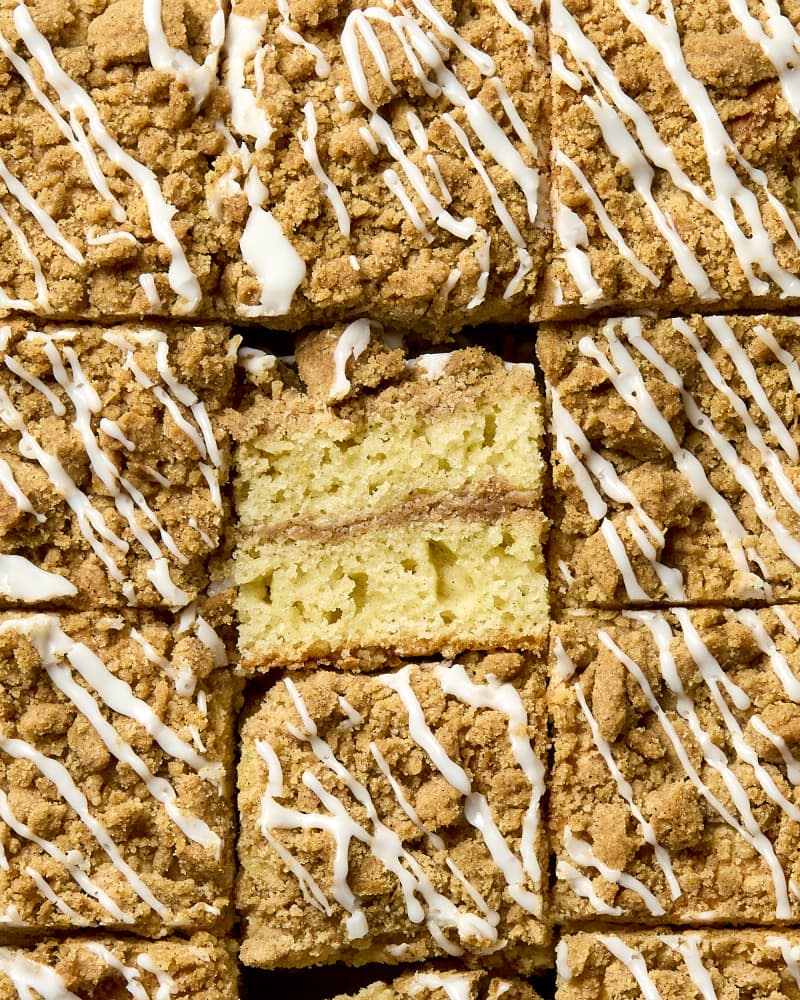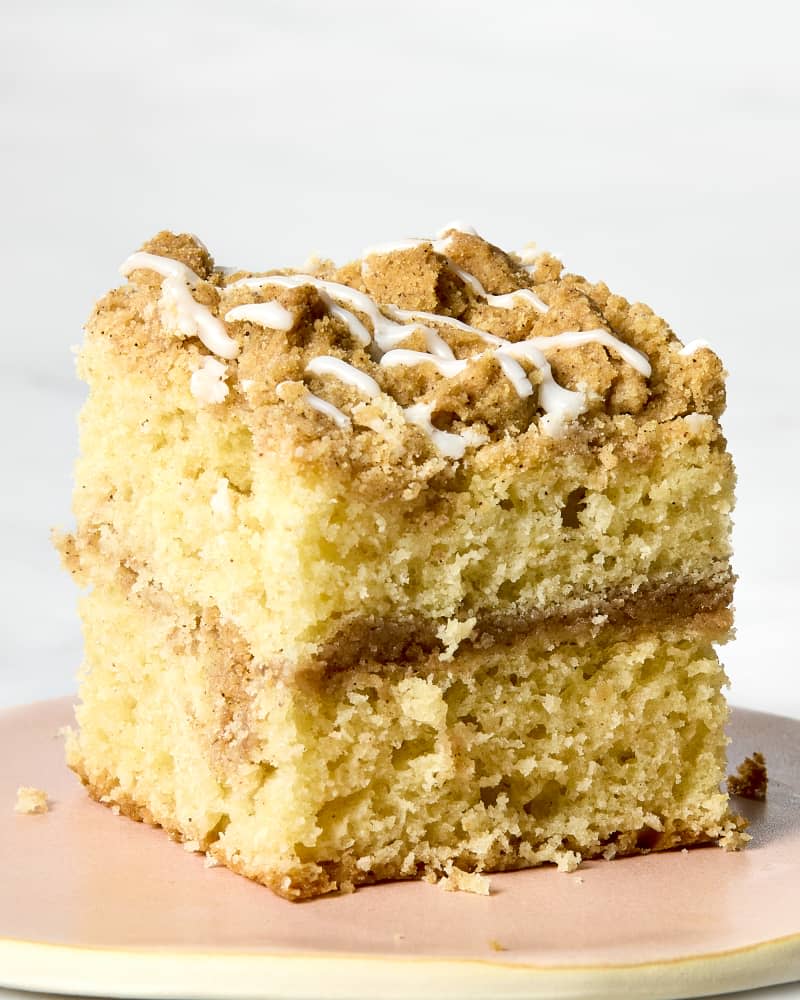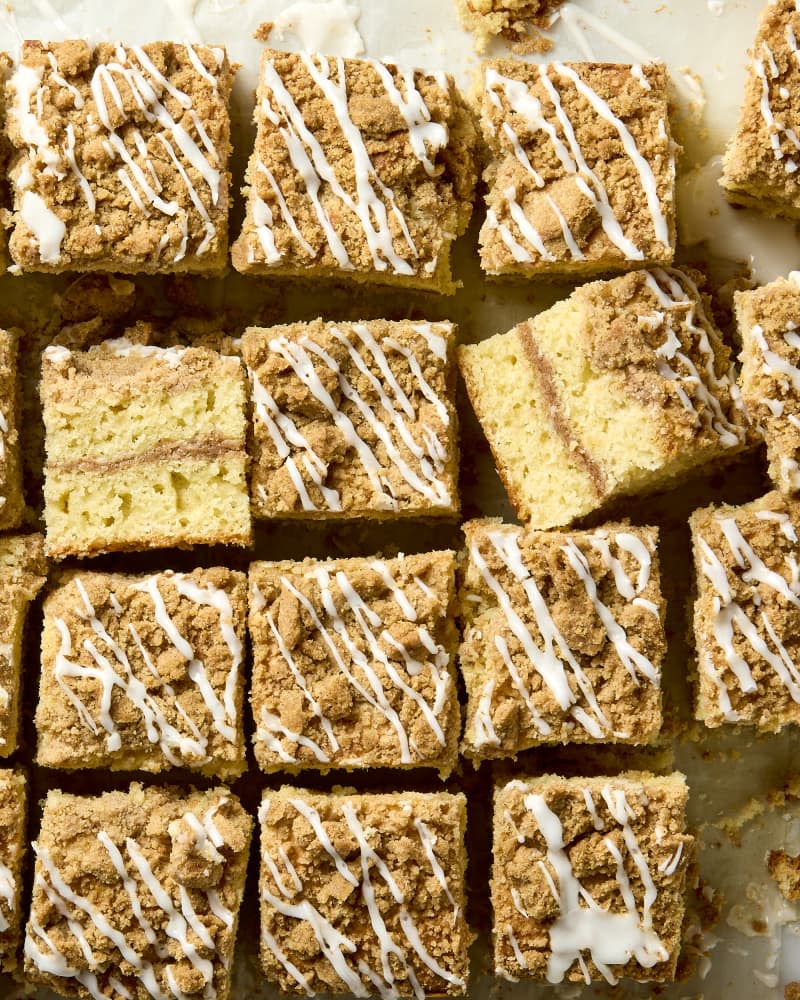My Extra-Buttery Coffee Cake Is Famous Among My Friends

I adore an everyday cake. Take coffee cake, for example — a simple slice with a cup of coffee (maybe French press if you have a few minutes) can bring so much joy. Despite the name, classic coffee cake contains no coffee. It’s traditionally a butter cake that’s made tangy with the addition of sour cream and is often crowned with a cinnamon-sugar crumb topping.
Coffee cake likely arrived in the U.S. by way of Germany, brought by immigrants in the 1800s. It’s an old-fashioned treat that clearly has staying power. In my version, an extra sprinkle of the crumbly topping snakes its way through the middle of the cake. For those with a sweet tooth, I’ve included an optional quick and easy icing — a drizzle over the top takes the cake to the next level.
Why You’ll Love It
The cake crumb is irresistibly light and fluffy, while the cinnamon crumb topping is perfectly crisp but not crunchy (which can be problematic with other coffee cakes).
You don’t need any special equipment! Because you’re making the batter with melted butter, everything comes together easily when you whisk it by hand.
Key Components in Coffee Cake
Topping. This recipe starts with the cinnamon crumb topping. Many crumb toppings call for stirring melted butter into flour and sugar to create a wet, sandy texture. I find this method produces a topping that is too crunchy and hard for the tender cake. Instead, I cut the cold butter into the brown sugar and flour similar to a pie crust or biscuits. The resulting crumbs are crisp without being crunchy.
Cake. I prefer to start with melted butter for the cake. Using the “muffin” method of making the batter means skipping the stand mixer or electric beaters. It’s a bit easier, and produces a coffee cake with a plush, looser crumb that I think is just lovely with the crumb topping.
Icing. While I kept it optional, a quick drizzle made from just powdered sugar and milk of any kind adds a touch of sweetness.

How to Make Coffee Cake
Make the cinnamon crumb topping. Add the flour, brown sugar, cinnamon, and salt to a large bowl. Cut in the cold butter with a pastry cutter, fork, or fingers until the largest pieces of butter are the size of peas. The mixture won’t look wet, but there should be no dry pockets of flour. It will resemble just-damp sand. Place the bowl in the refrigerator while you make the cake.
Make the cake. Melt the butter in a large bowl in the microwave until just barely melted. Whisk in the sugar, followed by the eggs, sour cream, and vanilla extract. Add the dry ingredients to the bowl. Mix all the ingredients together evenly. A few lumps are OK, but there should be no pockets of flour.
Assemble the cake. Dollop half the batter in a 9×13-inch baking dish, then spread evenly with a spatula. Sprinkle a layer of the cinnamon crumb over the top. Dollop the remaining batter over the cinnamon crumb and smooth over evenly. Pick up handfuls of the remaining topping and squeeze it together, then crumble it evenly over the top of the cake.
Bake the cake. Bake the cake at 350 degrees until the center of the cake is fully risen and springs back when lightly pressed, about 55 minutes.
Ice the cake. After the cake is cooled, whisk together powdered sugar with a couple spoonfuls of milk, then drizzle evenly over the cake. Let the icing harden before slicing and serving.

Storage and Make-Ahead Tips
Coffee cake keeps well and can definitely be made ahead of time. Cover it tightly and store at room temperature until ready to serve.
Any leftover cake will keep for up to 3 days at room temperature. You can even freeze it for up to 3 months. Thaw frozen cake at room temperature for a few hours before serving. Alternatively, microwave slices for 30 seconds, then in 15-second increments as needed until warmed through.
Coffee Cake Recipe
The keys to the best coffee cake? An extra layer of crumbly topping in the middle and an easy icing drizzled over the top.
Prep time 35 minutes to 45 minutes
Cook time 50 minutes to 55 minutes
Serves 15 to 18
Ingredients
For the topping and filling:
1 1/2 cups all-purpose flour
1 cup packed light brown sugar
2 teaspoons ground cinnamon
1/2 teaspoon kosher salt
12 tablespoons (1 1/2 sticks) cold unsalted butter
For the cake:
Cooking spray
2 sticks (8 ounces) unsalted butter
1 1/2 cups granulated sugar
3 large eggs
1 1/2 cups sour cream
2 teaspoons vanilla extract
3 cups all-purpose flour
2 teaspoons baking powder
1/2 teaspoon kosher salt
1/2 teaspoon ground nutmeg
1/4 teaspoon baking soda
For the icing (optional):
1 cup powdered sugar
2 tablespoons milk, any kind
Instructions
Make the topping:
Place 1 1/2 cups all-purpose flour, 1 cup packed light brown sugar, 2 teaspoons ground cinnamon, and 1/2 teaspoon kosher salt in a large bowl and whisk to combine.
Cut 12 tablespoons cold unsalted butter into small pieces. Add to the bowl. Use a pastry cutter, fork, or fingers to cut or rub the butter into the dry ingredients. Take care to mix the dry ingredients from the bottom of the bowl up to the top. Continue cutting or rubbing until the largest pieces of butter are the size of peas and the flour is no longer dry-looking, 3 to 5 minutes. The mixture should resemble damp sand.
Refrigerate while you make the cake. (If you only have 1 large bowl, transfer the topping to a smaller bowl so you can reuse the large bowl for the cake.)
Make the cake:
Arrange a rack in the middle of the oven and heat the oven to 350°F. Coat a 9x13-inch baking dish with cooking spray.
Cut 2 sticks unsalted butter into 16 pieces. Place in a large microwave-safe bowl. (No need to rinse the bowl first if reusing the topping bowl.) Microwave until melted, 1 to 1 1/2 minutes. (Alternatively, melt on the stovetop and transfer to a large bowl.)
Add 1 1/2 cups granulated sugar and whisk until combined. Add 3 large eggs one at a time, whisking well after each addition. Add 1 1/2 cups sour cream and 2 teaspoons vanilla extract and whisk to combine. Add 3 cups all-purpose flour, 2 teaspoons baking powder, 1/2 teaspoon kosher salt, 1/2 teaspoon ground nutmeg, and 1/4 teaspoon baking soda. Gently whisk the dry ingredients together on top of the wet. Switch to a flexible spatula and gently fold together until combined and no pockets of flour remain (batter will be very thick and slightly lumpy).
Dollop half the batter evenly into the baking dish (about 2 1/2 cups or 24 ounces). Use an offset spatula to smooth the batter into an even layer, going all the way to the edges. Sprinkle 1 1/2 cups of the topping evenly over the batter. Dollop the remaining batter evenly over the filling and spread into an even layer. Pick up handfuls of the remaining topping and squeeze it together. Crumble it evenly over the cake and repeat until all the topping is used up.
Bake until the center of the cake is fully risen and springs back when lightly pressed, 50 to 55 minutes. Let cool for at least 1 hour.
If making the icing, place 1 cup powdered sugar and 2 tablespoons milk in a small bowl and whisk until smooth. Drizzle over the cake. Let the icing set for a few minutes before cutting the cake and serving.
Recipe Notes
Make ahead: The cake can be made up to 1 day ahead. Let cool, cover, and store at room temperature.
Storage: Leftovers can be stored in an airtight container at room temperature for up to 3 days or frozen for up to 3 months. Thaw frozen cake at room temperature for a few hours. Alternatively, microwave slices for 30 seconds, then in 15-second increments as needed until warmed through.
A version of this recipe was first published in May 2016 by Emma Christensen.

